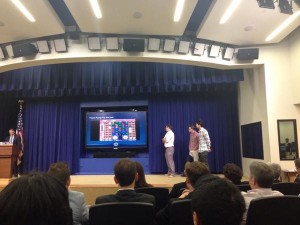
Team Pump Up the Jam from Baltimore, Md. shows their handiwork at the first-ever White House Game Jam.
The problem is as clear as it is daunting. Despite more money spent on education, student performance on learning outcomes have remained flat.
That’s where the White House Office of Science & Technology Policy hopes games can come in.
Mark DeLoura, Senior Advisor for Digital Media at the OSTP, welcomed 105 game developers, 15 teachers, and 10 policymakers in the first-ever White House Education Game Jam.
The event hoped to give form to the call from President Obama “for investments in educational technology that will help create digital tutors that are as effective as personal tutors, and educational software that’s as compelling as the best video game.”
And, according to DeLoura, there are proven benefits to using games in education. He pointed to the success of the Washington State Algebra Challenge and the SRI International meta-analysis study that showed a 12 percent improvement in learning outcomes with students who used digital games in the classroom.
The idea for the game jam was to gather these developers and policy experts to consider the issue not by discussing it but by developing prototypes for engaging educational games within 48 hours. The games were supposed to challenge the student, assess their progress and aid in correction, while at the same time be fun and engaging. The results were also be trackable for both the student and the teacher.
Developers and designers from large studios such as Sony PlayStation, Disney, Rovio and 1st Playables as well as GlassLab and BrainPop took on the challenge and presented their prototypes alongside those from indie studios and universities. Twenty-three teams participated in the #WHGameJam, including a ‘combo’ team consisting of members from an indie group and the academic publisher Pearson.
All 23 teams created prototypes that addressed subjects in the Common Core standards and/or Next Generation Science Standards that were identified as difficult by K-12 teachers and students working with the U.S. Department of Education and the Smithsonian.
At the game jam’s closing ceremony Ted Mitchell, Under Secretary at the U.S. Department of Education said, “the promise of games in education is extraordinary.” The Department of Education said they are focusing on the power of games to assess as they look for ways to move from summative assessment to embedded assessment.
As the teams developed their games, educators were on hand to serve as consultants. The White House OSTP wanted to ensure that the prototypes developed were not created in a vacuum, but involved the input of educators and students (who came in to play test the game). Tammie Schrader, Science Education and Teacher Ambassador Fellow Alumni, said that her “experience was amazing.” Her best moment “was explaining science to teams in order to make sure the concept was being portrayed accurately.”
She added she hoped that developers would continue “to build high quality, engaging games for kids with education in mind” and that “teachers realize that common core and next generation science standards are really just standards. There are fun ways to accommodate the state’s requirements and still have teaching be fun for kids and for teachers.”
Shawn Cook, Team Captain of Pump Up the Jam, a team of independent developers from the Baltimore area, said of his experience that it was “refreshing to make a game that tries to teach stuff instead of a game that tries to make money.” He went on to say that one the best parts of the Game Jam was “the feeling that we had a good idea that could have a real impact on education.”
The Game Jam is a “rapid, low cost experimentation”, said Tom Kalil, Deputy Director of OSTP, at the closing ceremony. “But, while it’s great to have a jam, it’s not sustainable,” he went on to say.
Kalil said he hoped some design firms would allow designers to take a summer sabbatical to design educational games, working at a time when they could connect with students and teachers over the summer. He challenged the group to come up with models that could motivate the best game developers to devote some resources and talent from games and entertainment towards games for learning.
But the weekend event also highlighted some of the major challenges facing the widespread adoption of games in the classroom. For example, Richard Culatta, director at the Office of Educational Technology at the U.S. Department of Education, said nearly 70 percent of schools don’t have access to high speed internet. He added that the Department of Education’s Connect Ed initiative and the Federal Communications Commission’s efforts to update E-rate, more than 70,000 school districts will be coming online unlike ever before.
While there was no clear winner, the hope is that the design studios will continue supporting these projects to see them through completion and into the hands of students.
And Culatta ended the day with a challenge to the scores of developers in the room, saying, “help signal to the rest of the game industry that transforming education is really a priority.”
